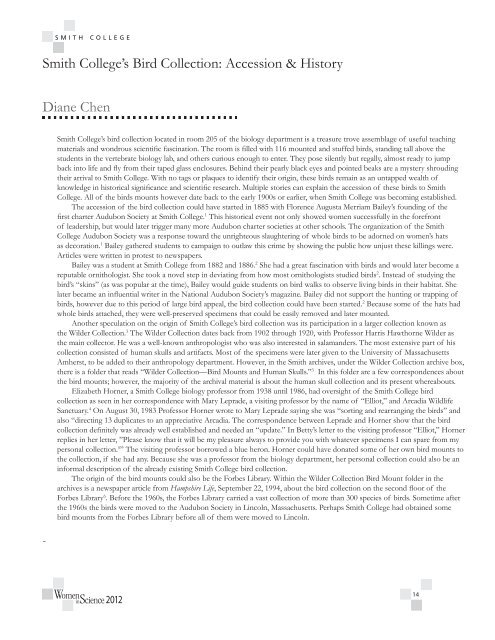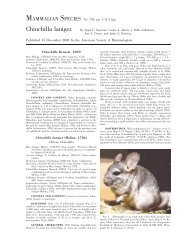Brugia Malayi - Clark Science Center - Smith College
Brugia Malayi - Clark Science Center - Smith College
Brugia Malayi - Clark Science Center - Smith College
You also want an ePaper? Increase the reach of your titles
YUMPU automatically turns print PDFs into web optimized ePapers that Google loves.
<strong>Smith</strong> <strong>College</strong>’s Bird Collection: Accession & History<br />
Diane Chen<br />
-<br />
<strong>Smith</strong> <strong>College</strong>’s bird collection located in room 205 of the biology department is a treasure trove assemblage of useful teaching<br />
materials and wondrous scientific fascination. The room is filled with 116 mounted and stuffed birds, standing tall above the<br />
students in the vertebrate biology lab, and others curious enough to enter. They pose silently but regally, almost ready to jump<br />
back into life and fly from their taped glass enclosures. Behind their pearly black eyes and pointed beaks are a mystery shrouding<br />
their arrival to <strong>Smith</strong> <strong>College</strong>. With no tags or plaques to identify their origin, these birds remain as an untapped wealth of<br />
knowledge in historical significance and scientific research. Multiple stories can explain the accession of these birds to <strong>Smith</strong><br />
<strong>College</strong>. All of the birds mounts however date back to the early 1900s or earlier, when <strong>Smith</strong> <strong>College</strong> was becoming established.<br />
The accession of the bird collection could have started in 1885 with Florence Augusta Merriam Bailey’s founding of the<br />
first charter Audubon Society at <strong>Smith</strong> <strong>College</strong>. 1 This historical event not only showed women successfully in the forefront<br />
of leadership, but would later trigger many more Audubon charter societies at other schools. The organization of the <strong>Smith</strong><br />
<strong>College</strong> Audubon Society was a response toward the unrighteous slaughtering of whole birds to be adorned on women’s hats<br />
as decoration. 1 Bailey gathered students to campaign to outlaw this crime by showing the public how unjust these killings were.<br />
Articles were written in protest to newspapers.<br />
Bailey was a student at <strong>Smith</strong> <strong>College</strong> from 1882 and 1886. 2 She had a great fascination with birds and would later become a<br />
reputable ornithologist. She took a novel step in deviating from how most ornithologists studied birds 2 . Instead of studying the<br />
bird’s “skins” (as was popular at the time), Bailey would guide students on bird walks to observe living birds in their habitat. She<br />
later became an influential writer in the National Audubon Society’s magazine. Bailey did not support the hunting or trapping of<br />
birds, however due to this period of large bird appeal, the bird collection could have been started. 2 Because some of the hats had<br />
whole birds attached, they were well-preserved specimens that could be easily removed and later mounted.<br />
Another speculation on the origin of <strong>Smith</strong> <strong>College</strong>’s bird collection was its participation in a larger collection known as<br />
the Wilder Collection. 3 The Wilder Collection dates back from 1902 through 1920, with Professor Harris Hawthorne Wilder as<br />
the main collector. He was a well-known anthropologist who was also interested in salamanders. The most extensive part of his<br />
collection consisted of human skulls and artifacts. Most of the specimens were later given to the University of Massachusetts<br />
Amherst, to be added to their anthropology department. However, in the <strong>Smith</strong> archives, under the Wilder Collection archive box,<br />
there is a folder that reads “Wilder Collection—Bird Mounts and Human Skulls.” 3 In this folder are a few correspondences about<br />
the bird mounts; however, the majority of the archival material is about the human skull collection and its present whereabouts.<br />
Elizabeth Horner, a <strong>Smith</strong> <strong>College</strong> biology professor from 1938 until 1986, had oversight of the <strong>Smith</strong> <strong>College</strong> bird<br />
collection as seen in her correspondence with Mary Leprade, a visiting professor by the name of “Elliot,” and Arcadia Wildlife<br />
Sanctuary. 4 On August 30, 1983 Professor Horner wrote to Mary Leprade saying she was “sorting and rearranging the birds” and<br />
also “directing 13 duplicates to an appreciative Arcadia. The correspondence between Leprade and Horner show that the bird<br />
collection definitely was already well established and needed an “update.” In Betty’s letter to the visiting professor “Elliot,” Horner<br />
replies in her letter, ”Please know that it will be my pleasure always to provide you with whatever specimens I can spare from my<br />
personal collection. 5 ” The visiting professor borrowed a blue heron. Horner could have donated some of her own bird mounts to<br />
the collection, if she had any. Because she was a professor from the biology department, her personal collection could also be an<br />
informal description of the already existing <strong>Smith</strong> <strong>College</strong> bird collection.<br />
The origin of the bird mounts could also be the Forbes Library. Within the Wilder Collection Bird Mount folder in the<br />
archives is a newspaper article from Hampshire Life, September 22, 1994, about the bird collection on the second floor of the<br />
Forbes Library 6 . Before the 1960s, the Forbes Library carried a vast collection of more than 300 species of birds. Sometime after<br />
the 1960s the birds were moved to the Audubon Society in Lincoln, Massachusetts. Perhaps <strong>Smith</strong> <strong>College</strong> had obtained some<br />
bird mounts from the Forbes Library before all of them were moved to Lincoln.<br />
2012<br />
14

















